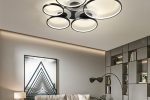Light switches are an essential component of every household, and with the rapid advancement of technology, they are gradually becoming smarter and more efficient. The futuristic light switch is an innovative piece of technology that is designed to enhance the user’s experience with various features that are not present in a traditional light switch. This article aims to provide an in-depth review of the futuristic light switch, highlighting its features, benefits, limitations, and the impact it will have on the future of home automation.
Features of the Futuristic Light Switch
The futuristic light switch is designed to provide a wide range of features that are not typically found in a traditional light switch. Here are some of the key features of the futuristic light switch:
1. Voice Control
One of the most notable features of the futuristic light switch is its voice control capability. Using a voice assistant such as Amazon Alexa or Google Assistant, users can control their lights simply by using voice commands. This feature is particularly beneficial for individuals with physical disabilities or those who have difficulty operating a traditional light switch.
2. Motion Sensors
The futuristic light switch also comes with motion sensors that detect when someone enters or exits a room. With this feature, the light will automatically turn on when someone enters the room and turn off when they leave. This is a great energy-saving feature as it ensures that lights are not left on unnecessarily.
3. Smart Scheduling
With the futuristic light switch, users can also schedule when their lights turn on and off automatically. This is particularly useful for individuals who are away from home for extended periods. By setting up a schedule, users can make their home appear occupied, thereby deterring potential burglars.
4. Mobile App Control
Smartphone apps are becoming increasingly popular as a means of controlling smart home devices. The futuristic light switch also comes with a mobile app, which allows users to control their lights from anywhere in the world. This feature is particularly useful for individuals who want to turn their lights on or off while away from home.
Benefits of the Futuristic Light Switch
The futuristic light switch has several benefits, most notably its energy-saving capabilities. By turning off lights automatically when a room is unoccupied, users can save a significant amount of energy and reduce their electricity bills.
The voice control feature is also beneficial for individuals with disabilities or mobility issues. With this feature, individuals can control their lights without the need to get up, providing an added level of convenience.
Limitations of the Futuristic Light Switch
Despite its many features and benefits, the futuristic light switch does have a few limitations. The motion sensor may not be ideal for individuals with pets, as the light may turn on when the pet enters the room. Additionally, the mobile app may not be user-friendly for individuals who are not tech-savvy or those who have difficulty using a smartphone.
The Impact of the Futuristic Light Switch on Home Automation
The futuristic light switch represents a significant step forward in the field of home automation, and its impact is likely to be far-reaching. By providing users with greater control over their lighting, the futuristic light switch is expected to become an integral part of smart home systems.
As technology continues to advance, it is likely that the light switch will become even smarter, with features such as facial recognition and personalized lighting preferences. The future of home automation is looking increasingly bright, with the futuristic light switch at the forefront of this exciting technology.
The futuristic light switch is an innovative technology that is designed to enhance the user’s experience by providing a wide range of features not found in a traditional light switch. With its energy-saving capabilities, voice control, motion sensors, and mobile app control, the futuristic light switch represents a significant step forward in the field of home automation. While it does have a few limitations, its impact on home automation is expected to be far-reaching, with the potential for even more advanced features in the near future.




